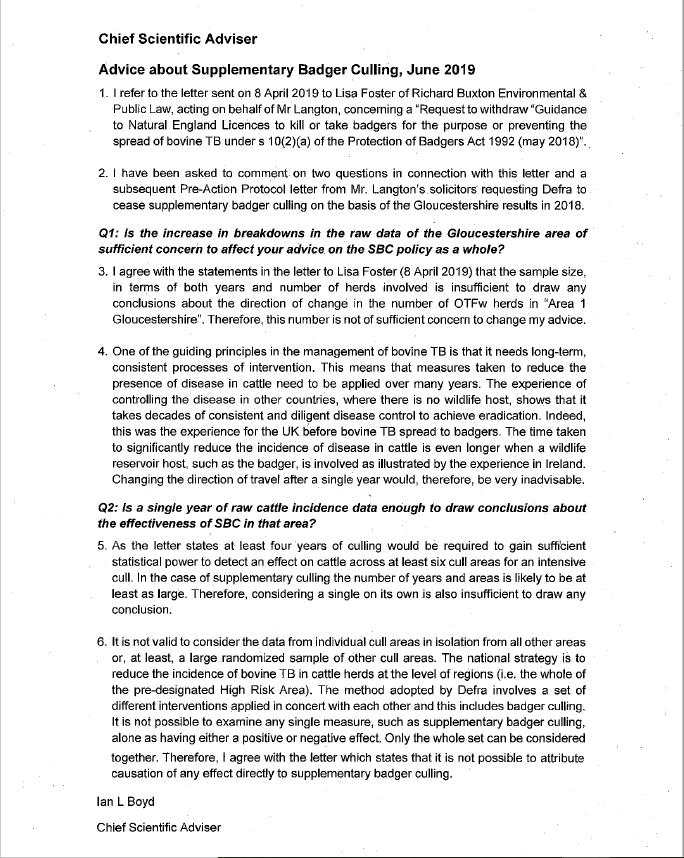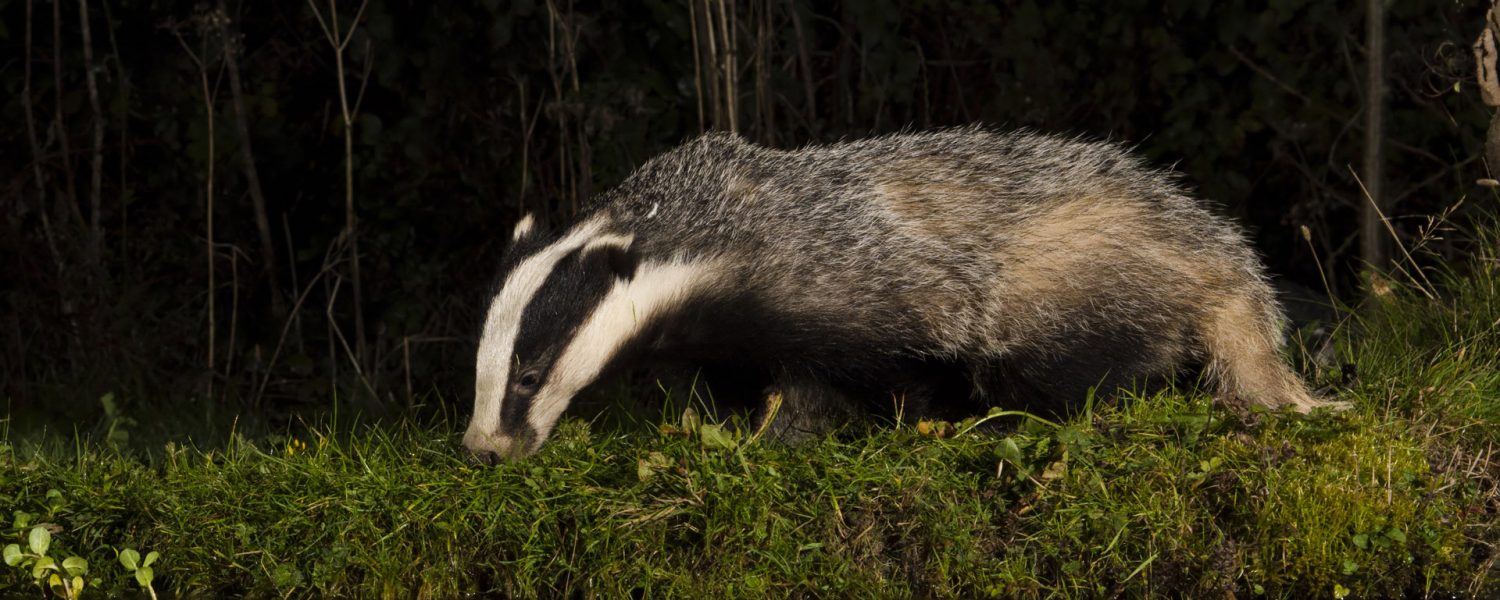C1/2018/2332 The Queen on the application of Langton -v- The Secretary of State for the Environment Food and Rural Affairs & Anr. Appeal of Claimant from the order of Sir Ross Cranston, dated 15th August 2018.
Before
- THE LORD CHIEF JUSTICE OF ENGLAND & WALES and
- LORD JUSTICE SINGH and
- LADY JUSTICE NICOLA DAVIES
Tuesday, 2nd July, 2019
At half-past 10
Tomorrow, Tuesday 2nd July, the Court of Appeal will consider whether the decision a year ago by a High Court judge to dismiss challenges to major elements of Defra and Natural England’s approach to badger culling in 2017 was right. Defra’s controversial policy that year to kill more badgers for longer, to prevent the English Bovine TB cattle disease crisis will come under fresh legal scrutiny, as will impacts on the ecological interest of nature sites of international significance.
The Court of Appeal will consider whether Sir Ross Cranston, sitting as a High Court judge in July 2018, wrongly dismissed the legal challenges brought by claimant ecologist Tom Langton against two elements of badger culling. These were namely, the decision of the Secretary of State for the Environment Food and Rural Affairs (SSEFRA) to pursue a policy of ‘supplementary culling’ of badgers, and the decisions of Natural England (NE) to issue licences in 2017 for badger culling affecting internationally important nature conservation sites in Devon, Dorset, Somerset, Cheshire and Wiltshire.
Breach of Protection of Badgers Act 1992
Mr Langton’s challenge against the SSEFRA’s pursuit of supplementary culling exposes that government has cut both costs and corners in considering the scientific evidence for its new approach to shooting badgers, introduced by Defra in 2017.
The claim is that the Government has approved a method that has no scientific basis and that has been advised against by published studies suggesting that the approach might even be counter-productive in the fight against bovine TB. This was also pointed out by the Zoological Society of London experts after the suggested method was made public.
The Protection of Badgers Act 1992 may be breached if culling is done merely on an experimental basis to stop spread of disease when there is no robust scientific evidence or certainty that this will work. The Government’s actions were found to be lawful by Sir Ross Cranston on the basis that the government argued it was able to adapt to and learn from any findings once the method is adopted. In recent weeks the Chief Scientific Advisor and Chief Veterinary Officer and a Natural England scientist have denied that a spike in bTB in the Gloucestershire pilot study and a slight rise in the Somerset pilot area in 2018 indicate that the method may be making things worse.
Important Nature Sites at Risk
On the second Ground of Appeal, Mr Langton’s challenge against Natural England centres around the duty on NE under UK and European law to ascertain that internationally important nature conservation sites are not adversely affected by badger culling operations. In the case before Sir Ross Cranston, Mr Langton had claimed that NE’s assessments pursuant to this duty were cursory and inadequate and as a consequence the decisions to sanction badger culling made on the back of them were unlawful.
In the High Court in July 2018, Justice Cranston agreed with Mr Langton that NE had breached certain of its duties under the Habitats Regulations. However, he accepted NE’s case that correction of the errors in their assessments would make ‘no difference’ to their conclusions and consequently he did not quash the badger culling licences.
The Court of Appeal will decide whether he was right not to do so. The Court will also decide whether he was correct to accept various measures to limit the possibility of impacts on international sites. One example was that culling stand-off zones near known high tide roosts for wading birds (which were imposed as conditions on the culling licences) were not ‘mitigation’ and could therefore be relied upon to ‘screen out’ sites from more detailed consideration. This is an approach that has since been found to be unlawful under European law.
Government has cut both costs and corners
Campaigners state that government has failed completely on the scientific monitoring that is required for any safe and proper assessment of new methods to shoot badgers, introduced in 2017.
Corners have been cut because;
- Badger numbers are crudely guess-estimated and not properly assessed as is essential in determining population sizes; a vital consideration.
- Natural England backtracked on requiring data from cull companies on fox and other predator control numbers in and around cull areas.
- Natural England claimed to the court that their staff would know if any negative effects were happening on protected sites while at the same time stating in public that their ability to monitor SSSIs was seriously diminished.
ClaimantTom Langton said:
‘’ The understanding that badger culling may now be making things worse rather than better or having no effect at all is quite sobering and I hope the government will take time to reflect. What they should have realised in 2017 when they went ahead, was that they had no ability at all to learn from what was being proposed. It was and remains a huge mistake.
Our wildlife sites have been threatened by Natural England whose job it is to protect them. We think that Natural England’s defence is wrong and a damning indictment of their capacity and abilities. The court has found that they have breached their duties and now they are trying to justify, with dismissive language, feeble safeguards that neglect responsible protection of nature.
More badgers have been killed and injured during the year since the first hearing. The Minister should now intervene and take urgent steps, beginning with cancelling this year’s supplementary badger culls in order to rethink the policy. Claims by senior politicians that culls are working are founded upon briefings by Defra officials, based on mistaken or overstated understanding of the scientific evidence.’’
Habitat Regulations expert Dominic Woodfield said:
“Natural England earnestly reassured Justice Cranston last year that they will instantly respond to any emerging evidence of impacts on sensitive bird populations and other features, including those underpinning internationally important wildlife sites. These reassurances have been shown to be baseless platitudes.
One cannot respond to evidence of a negative effect that one is not looking for. The reality is that Natural England has conducted next to no routine monitoring of species populations on the European Sites threatened by badger culling, and is therefore not in any position to use any such monitoring as a miner’s canary to signal when protective steps ought to be taken.
It is telling that in the time they bought by reassuring the High Court last year, Natural England has sought to overhaul its impact assessments in a manner that precisely vindicates Mr Langton’s original claims, and as a consequence they now claim that quashing any 2017 decisions would be academic.
It will be for the Court of Appeal to decide whether this really is an academic matter having regard to all the changes to procedure and conditions that have been forced by Mr Langton’s challenges and whether those changes, welcome as they are, go far enough to protect vulnerable wildlife and fulfill our international obligations.”


